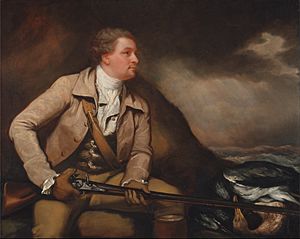William Elford facts for kids
Quick facts for kids
William Elford
|
|
|---|---|
 |
|
| Born | August 1749 |
| Died | 30 November 1837 |
| Occupation | Politician |
| Branch | British Army |
Sir William Elford (born August 1749, died November 30, 1837) was an important English figure. He was a banker, a politician, and also a talented artist. He was known as the 1st Baronet of Bickham.
Contents
Early Life and Family Connections
William Elford came from a very old family in the west of England. His family lived in a place called Bickham, which is in Buckland Monachorum, Devon. His father was Reverend Lancelot Elford. His mother was Grace, whose father was Alexander Wills from Kingsbridge, Devonshire.
Political and Business Career
William Elford was a partner in a banking company in Plymouth. The company was called Elford, Tingcombe, & Clerk. He was also involved in many other important roles in Plymouth.
Roles in Plymouth and Totnes
From 1797 to 1833, he served as the Recorder of Plymouth. A Recorder is like a judge who helps with legal matters in a town. After that, he was the Recorder for Totnes from 1832 to 1834.
Serving in Parliament
Elford was elected as a Member of Parliament (MP) for Plymouth. He served from 1796 to 1806. An MP is someone elected to represent a group of people in the country's government. He later represented Westbury for a short time. In 1807, he became an MP for Rye but left that role in 1808.
Military Service
He was also a lieutenant-colonel in the South Devon Militia. This was a local army group. He went with his regiment to Ireland during the Irish rebellion in 1798–1799. On November 29, 1800, he was given the special title of a baronet. This meant he became "Sir William Elford, 1st Baronet, of Bickham."
Scientific and Artistic Talents
William Elford was a very smart person with many interests. He was a good friend of William Pitt the Younger, who was a famous Prime Minister. Elford also enjoyed visiting Bath, where he played whist, a popular card game. He met many famous writers and artists there.
Scientific Discoveries
Elford was very good at science. In 1790, he became a Fellow of the Royal Society. This is a very old and respected group for scientists. In 1813, he joined the Linnaean Society, which focuses on plants and animals. Before he died, he shared his findings about a new way to make yeast. His discoveries were quite interesting to people.
A Talented Artist
Elford was also an excellent artist. He showed his paintings at the Royal Academy exhibitions for many years, from 1774 to 1837. His pictures were known for being tasteful and well-drawn. He even painted one when he was 89 years old!
- You can find three of his drawings at the British Museum.
- His most important painting was 'The White Lady of Avenel', which he showed in 1822.
- He gave a landscape painting to the Prince Regent in 1819, which is now at Windsor Castle.
- He also gave his paintings to the University of Oxford and to his friends.
Personal Life and Legacy
Later in his life, William Elford faced financial difficulties. His bank had problems in 1825, and he had to sell his family home in Bickham. He then lived at the Priory in Totnes, which was his son-in-law's home.
Family
He was married twice. His first wife was Mary Davies. They had one son, Jonathan, who died without children. They also had two daughters: Grace and Elizabeth. Elizabeth married General Sir George Pownoll Adams. Elford's second wife was Elizabeth Hall.
Later Years and Friends
William Elford passed away on November 30, 1837, when he was 89 years old. He was buried in the local church, where there is a special plaque to remember him. When he died, his baronet title ended because he had no living sons to pass it on to.
The painter James Northcote was a close friend of the Elford family. He painted many portraits of them.
Elford also exchanged many letters with the writer Mary Mitford. Their letters were later collected and published in two books.

